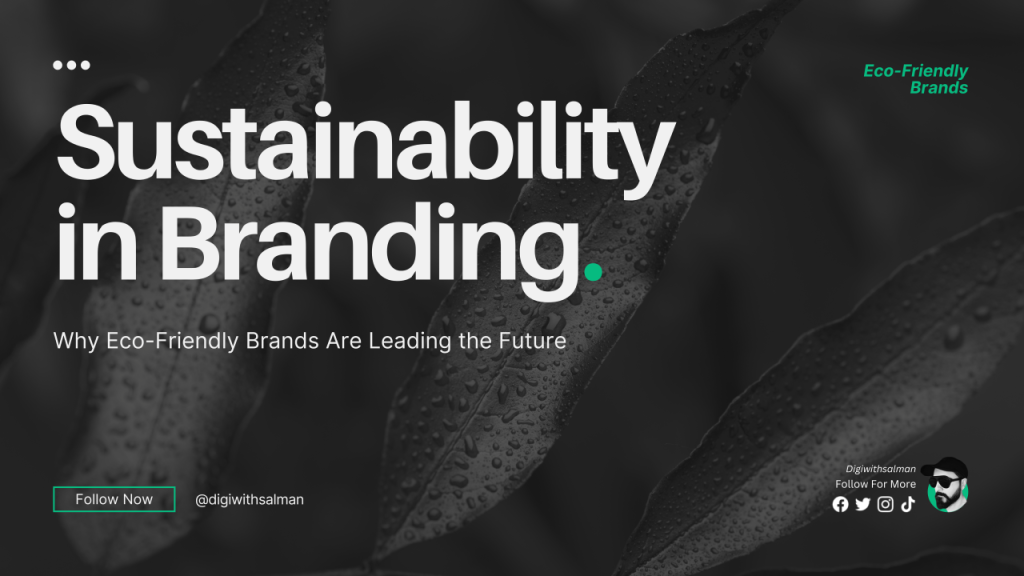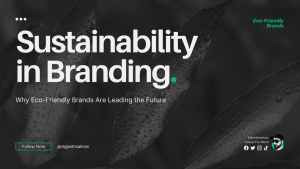In a world that’s becoming increasingly conscious of environmental impact, sustainability has transitioned from being a trendy buzzword to a critical business practice. For future-conscious companies, eco-friendly branding is not just an option but a necessity. Customers are now choosing brands that not only offer quality but also align with their values of sustainability and ethical responsibility.
This shift towards sustainability in branding is creating opportunities for companies to differentiate themselves, build trust, and contribute positively to the environment. But how exactly are leading brands adopting eco-friendly approaches? Let’s explore.

1. Why Sustainability in Branding Matters
The modern consumer is more informed and concerned about their choices. According to a Nielsen study, 66% of global consumers are willing to pay more for sustainable goods. This statistic is even higher among millennials, with 73% preferring brands that demonstrate a commitment to the environment.
Brands that embrace sustainability aren’t just appealing to a niche market—they’re positioning themselves as leaders in the future of business. Here’s why sustainability in branding is so crucial:
- Consumer Trust and Loyalty: Sustainable brands build stronger relationships with consumers who value eco-friendly practices. This translates into long-term loyalty and brand advocacy.
- Regulatory Compliance: Governments worldwide are enforcing stricter environmental regulations. Adopting sustainable practices now can prevent potential fines and damage to a brand’s reputation.
- Future-Proofing: As resources become scarcer, companies that invest in sustainable practices now will have a competitive edge in the future.

2. Examples of Brands Successfully Adopting Sustainability
Many forward-thinking companies are already embedding sustainability into their brand DNA. These brands serve as role models for those looking to create a positive environmental impact while driving business growth.
Patagonia: A Leader in Eco-Conscious Branding
Patagonia has become synonymous with environmental activism. The company has long embraced sustainability by using recycled materials in its products and ensuring fair labor practices across its supply chain. Patagonia even encourages customers to repair and reuse their products instead of buying new ones, a rare move in the retail industry. Their message is clear: buy less, choose well, and care for the planet.
Unilever: A Commitment to Sustainable Living
Unilever, a global consumer goods giant, has committed to reducing its environmental footprint and improving the social impact of its products. With its “Sustainable Living Plan,” the company aims to decouple its growth from environmental harm. Unilever’s eco-friendly brands, such as Dove and Seventh Generation, have seen significant growth, proving that sustainability resonates with consumers.
IKEA: Towards a Circular Economy
IKEA has made strides in reducing its environmental impact by committing to becoming a fully circular business by 2030. This means designing products that can be reused, refurbished, or recycled. IKEA has also pledged to use only renewable or recycled materials in its products and aims to achieve zero-emissions home delivery.
3. How to Integrate Sustainability into Your Brand
Whether you’re an established company or a startup, integrating sustainability into your branding can set you apart in a crowded marketplace. Here are some actionable steps:
- Audit Your Supply Chain: Start by assessing the environmental impact of your supply chain. Look for opportunities to reduce waste, use renewable energy, and source materials responsibly.
- Transparency and Communication: Be transparent with your customers about your sustainability efforts. Share your goals, challenges, and progress regularly through your marketing channels.
- Product Innovation: Innovate your products to be more eco-friendly. This could mean using sustainable materials, designing for longevity, or minimizing packaging waste.
- Engage Your Audience: Educate and involve your customers in your sustainability journey. Brands that effectively communicate their eco-friendly initiatives can foster a deeper connection with their audience.
Conclusion: The Future Belongs to Sustainable Brands
In an era where consumers are making more conscious choices, eco-friendly branding is not a trend—it’s the future. Brands that prioritize sustainability will not only contribute to the health of the planet but also secure their place in the hearts and minds of customers.
By adopting eco-friendly practices and clearly communicating them, companies can build stronger connections with their audience, improve brand loyalty, and ensure long-term success. The future of branding is sustainable—are you ready to lead the way?





One Response
Hi, this is a comment.
To get started with moderating, editing, and deleting comments, please visit the Comments screen in the dashboard.
Commenter avatars come from Gravatar.